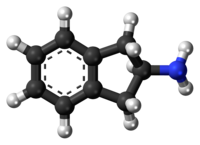2-Aminoindane
 | |
 | |
| Clinical data | |
|---|---|
| Other names | 2-indanylamine; 2-indanamine |
| Routes of administration | Oral |
| ATC code |
|
| Legal status | |
| Legal status |
|
| Identifiers | |
| |
JSmol) | |
| |
| |
| | |
2-Aminoindane (2-AI) is a research chemical with applications in neurologic disorders and psychotherapy that has also been sold as a designer drug.[1] It acts as a selective substrate for NET and DAT.[2][3]
Therapeutic and illicit uses
Synthetic aminoindanes were originally developed in the context of anti-Parkinsonian drugs as a metabolite of rasagiline and as a tool to be used in psychotherapy. Deaths related to their toxic effects have been observed both in the laboratory in animal studies and in clinical encounters.[4] 2-AI is a rigid analogue of amphetamine and partially substitutes for it in rat discrimination tests.[5]
Chemical derivatives
There are a number of
- 5-IAI
- Aprindine
- ETAI
- Indanorex
- Indantadol
- Jimscaline
- Ladostigil
- MDAI
- MEAI
- MDMAI
- MMAI
- NM-2-AI
- PNU-99,194
- Rasagiline
- TAI
Legal status
China
As of October 2015 2-AI is a controlled substance in China.[6]
Sweden
Sweden's public health agency suggested classifying 2-AI as a hazardous substance, on June 24, 2019.[7]
United States
2-Aminoindane is not scheduled at the federal level in the
See also
- 2-Aminodilin(2-AD)
- 2-Aminotetralin (2-AT)
- Amphetamine
- Bath salts (drug)
References
- PMID 31667988.
- PMID 30904940.
- PMID 24486525.
- PMID 29204127.
- S2CID 19069907.
- ^ "关于印发《非药用类麻醉药品和精神药品列管办法》的通知" [On the issuance of non-pharmaceutical narcotic drugs and psychotropic substances listed in the notice] (in Chinese). China Food and Drug Administration. 27 September 2015. Archived from the original on 1 October 2015. Retrieved 1 October 2015.
- ^ "Åtta ämnen föreslås klassas som narkotika eller hälsofarlig vara" [Eight substances are proposed to be classified as narcotics or dangerous to health] (in Swedish). Folkhälsomyndigheten. 24 June 2019.
- ^ "21 CFR — SCHEDULES OF CONTROLLED SUBSTANCES §1308.11 Schedule I." Archived from the original on 2009-08-27. Retrieved 2018-02-14.
External links
 Media related to 2-Aminoindane at Wikimedia Commons
Media related to 2-Aminoindane at Wikimedia Commons
